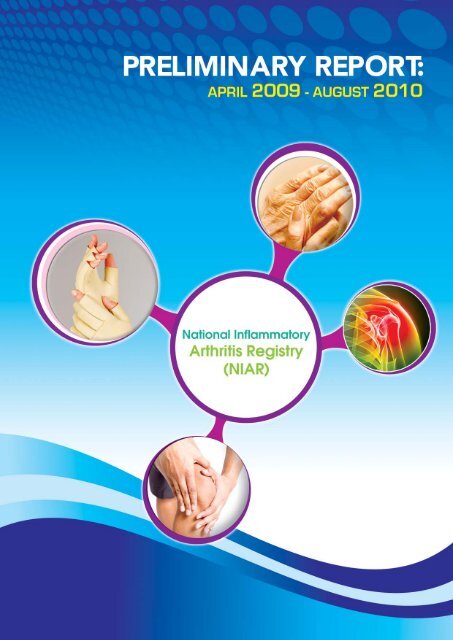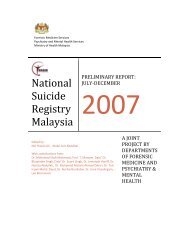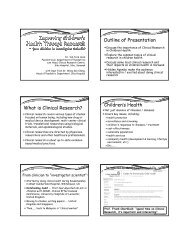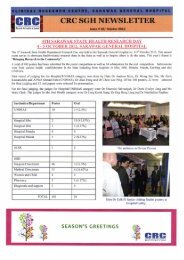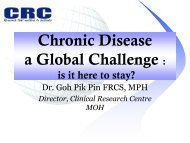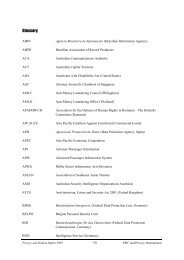laporan tahunan hospital selayang.indd - CRC
laporan tahunan hospital selayang.indd - CRC
laporan tahunan hospital selayang.indd - CRC
Create successful ePaper yourself
Turn your PDF publications into a flip-book with our unique Google optimized e-Paper software.
ii<br />
PRELIMINARY REPORT: APRIL 2009 - AUGUST 2010<br />
National Infl ammatory Arthritis Registry (NIAR)<br />
Published by:<br />
Na onal Infl ammatory Arthri s Registry (NIAR)<br />
Clinical Research Centre, 4th fl oor Specialist offi ce<br />
Selayang Hospital, Selayang-Kepong Highway<br />
68100 Batu Caves, Selangor<br />
Malaysia<br />
Direct line : (603) 6120233 ext 9111/4169<br />
Fax : (603) 61202761<br />
Website : h ps://app.acrm.org.my/NIAR<br />
Disclaimer : Data reported here are supplied by the NIAR. Interpreta on and<br />
repor ng of these data are the responsibility of the editors and in<br />
no way should be seen as an offi cial policy or interpreta on of the<br />
NIAR. This report is copyright. However it can be freely reproduced<br />
without the permission of the NIAR. However, acknowledgement<br />
would be appreciated.<br />
Suggested cita on : The suggested cita on for this report is as follows:<br />
Dr Azmillah Rosman, Dr Hasselynn Hussein,<br />
Dr Gun Suk Chyn, Dr Lau Ing Soo,<br />
Dr Mollyza Mohd. Zain, Dr Habiba @ Habibah Mohd Yusoof<br />
Dr Asmahan Mohamed Ismail, Dr Liza Mohd.Isa,<br />
Dr Nor Shuhaila Shahril, Dr Ramani Arumugam,<br />
Dr Ong Yew Chong<br />
ISSN No :
CONTENTS<br />
ACKNOWLEDGEMENTS<br />
STEERING COMMITTEE MEMBERS<br />
MEMBERS OF THE ADVISORY BOARD<br />
LIST OF CONTRIBUTORS<br />
ABOUT NIAR<br />
Objec ve<br />
Inclusion Criteria<br />
Instrument<br />
Data Flow Process<br />
Progress<br />
1. DISTRIBUTION OF CASES ACCORDING TO HOSPITAL<br />
2. DEMOGRAPHICS<br />
2.1 GENDER DISTRIBUTION<br />
2.2 AGE DISTRIBUTION<br />
2.3 ETHNIC GROUP<br />
2.4 SOCIOECONOMIC STATUS<br />
2.4.1 PROFESSIONAL VS NON-PROFESSIONAL<br />
2.4.2 INCOME GROUP<br />
2.4.3 PERSONAL MEDICAL INSURANCE<br />
3. CHARACTERISTICS OF PATIENTS<br />
3.1 NUMBER OF PATIENTS FULFILLING ACR CRITERIA<br />
3.2 DURATION OF DISEASE BEFORE DIAGNOSIS<br />
3.3 ASSOCIATED MEDICAL PROBLEMS<br />
3.3.1 MEDICAL CO-MORBIDITIES<br />
3.3.2 MALIGNANCIES<br />
3.4 EXTRAARTICULAR MANIFESTATIONS<br />
3.5 DISEASE STATUS AT 1ST NOTIFICATION<br />
PRELIMINARY REPORT: APRIL 2009 - AUGUST 2010<br />
National Infl ammatory Arthritis Registry (NIAR)<br />
4. DISEASE BURDEN<br />
4.1 WORK STATUS<br />
4.2 DAYS OF SICK LEAVE TAKEN DUE TO ARTHRITIS IN THE PAST 3<br />
MONTHS<br />
5. STANDARD OF CARE<br />
5.1 TIME TO INITIATION OF DMARDS AFTER DIAGNOSIS<br />
5.2 TYPES OF DMARDS USED<br />
1<br />
2<br />
2<br />
3<br />
5<br />
6<br />
6<br />
6<br />
6<br />
7<br />
9<br />
11<br />
12<br />
12<br />
13<br />
14<br />
14<br />
15<br />
15<br />
17<br />
18<br />
19<br />
20<br />
20<br />
21<br />
21<br />
22<br />
25<br />
26<br />
26<br />
27<br />
28<br />
29<br />
iii
iv<br />
PRELIMINARY REPORT: APRIL 2009 - AUGUST 2010<br />
National Infl ammatory Arthritis Registry (NIAR)<br />
5.3 USE OF COMBINATION DMARDS<br />
5.4 USE OF BIOLOGICS<br />
5.5 USE OF ORAL STEROIDS<br />
5.6 USE OF NSAIDS/COX2 INHIBITORS<br />
5.7 SURGERY<br />
DISCUSSION<br />
CONCLUSIONS AND RECOMMENDATIONS<br />
REFERENCES<br />
APPENDIX I : CASE REPORT FORM<br />
APPENDIX II : INFORMATION ON PATIENT CONFIDENTIALITY<br />
29<br />
30<br />
30<br />
30<br />
30<br />
31<br />
33<br />
35
ACKNOWLEDGMENTS<br />
PRELIMINARY REPORT: APRIL 2009 - AUGUST 2010<br />
National Infl ammatory Arthritis Registry (NIAR)<br />
The Na onal Infl ammatory Arthri s Registry would like to express its sincere thanks and<br />
apprecia on to all who have supported and contributed to this report.<br />
We thanks the following for their support:<br />
• The Ministry of Health, Malaysia<br />
• Y.B. Tan Sri Dato’ Seri Dr Hj Mohd Ismail Merican, Director General of Health,<br />
Malaysia<br />
• Dr Lim Teck Onn, Director, Network of Clinical Research Centre<br />
• Dr Goh Pik Pin, Co-Director, Network of Clinical Research Centre<br />
• Dr Jamaiyah Haniff , Head of Clinical Epidemiology Unit of <strong>CRC</strong><br />
• Informa on technology personnelnamely MS Lim Jie Ying, database administrator,<br />
Ms Teo Jau Shya, clinical data manager<br />
• Members of the “Steering Commi ee” for their contribu ons to the registry<br />
• Clinical Research Centre, Ministry of Health, Malaysia<br />
• Other sponsors and supporters from the professional bodies, industries and<br />
ins tua ons as listed below:<br />
Ka Consul ng Sdn. Bhd<br />
Schering Plough<br />
Staff from Hospital Selayang, Hospital Tuanku Jaafar, Seremban and<br />
Hospital Putrajaya<br />
1
2<br />
PRELIMINARY REPORT: APRIL 2009 - AUGUST 2010<br />
National Infl ammatory Arthritis Registry (NIAR)<br />
STEERING COMMITTEE MEMBERS<br />
Dr Azmillah Rosman (Principal Inves gator)<br />
Department of Medicine, Hospital Selayang<br />
Dr Chow Sook Khuan<br />
Sunway Medical Centre<br />
Dr Amir Azlan Zain<br />
Sunway Medical Centre<br />
Dr Heselynn Hussein<br />
Department of Medicine, Hospital Putrajaya<br />
Dr Gun Suk Chyn<br />
Department of Medicine, Hospital Tuanku Abdul Jaafar, Seremban<br />
Dr Lau Ing Soo<br />
Department of Medicine, Hospital Selayang<br />
Dr Mollyza Mohd Zain<br />
Department of Medicine, Hospital Selayang<br />
MEMBERS OF THE ADVISORY BOARD<br />
Dr Lim Teck Onn (Chairman)<br />
Clinical Research Centre, Ministry of Health Malaysia<br />
Tan Sri Hari Narayanan (Co-chairman)<br />
Arthri s Founda on Malaysia<br />
Ms Ding Mee Hong<br />
Arthri s Founda on Malaysia<br />
Professor Florence Wang<br />
University Malaya Medical Centre
LIST OF CONTRIBUTORS<br />
Hospital Selayang<br />
Dr Azmillah Rosman<br />
Dr Lau Ing Soo<br />
Dr Mollyza Mohd Zain<br />
Dr Habibah Mohd Yusoof<br />
Dr Asmahan Mohamed Ismail<br />
Dr Chong Hwee Cheng<br />
Dr Kuan Woon Pang<br />
Dr Ramani Arumugam<br />
Dr Shereen Ch’ng Suyin<br />
Dr Hilmi Abdullah<br />
Dr Ong Yew Chong<br />
Mdm Ramlah Shukor<br />
Mdm Norlela Mohd Salleh<br />
Hospital Tuanku Jaafar, Seremban<br />
Dr Gun Suk Chyn<br />
Dr Beryl D’Sauza<br />
Dr C Gandhi<br />
Dr Lim Ai Lee<br />
Dr Nadia Mohd Noor<br />
Mdm Ho Ah May<br />
Hospital Putrajaya<br />
Dr Heselynn Hussein<br />
Dr Eashwary Mageswaren<br />
Dr Liza Mohd Isa<br />
Dr Nor Shuhaila Shahril<br />
Dr Shamala Rajalingam<br />
Mdm Amnahliza Abu Rahman<br />
PRELIMINARY REPORT: APRIL 2009 - AUGUST 2010<br />
National Infl ammatory Arthritis Registry (NIAR)<br />
3
ABOUT THE NATIONAL<br />
INFLAMMATORY ARTHRITIS<br />
REGISTRY (NIAR)
6<br />
PRELIMINARY REPORT: APRIL 2009 - AUGUST 2010<br />
National Infl ammatory Arthritis Registry (NIAR)<br />
ABOUT THE NATIONAL INFLAMMATORY ARTHRITIS REGISTRY (NIAR)<br />
Introduc on<br />
Rheumatoid Arthri s (RA), the most common form of infl ammatory arthri s is es mated<br />
to aff ect about 1% of the popula on. Of unknown ae ology, it typically aff ects many joints,<br />
causing acute infl amma on, in most cases leading to joint erosions and joint damage (1).<br />
The NIAR, ini ated in 2008, was set up with the aim of obtaining informa on about pa ents<br />
with Rheumatoid Arthri s. Informa on about pa ents with the other infl ammatory<br />
arthri des will be collected in the future.<br />
Objec ves<br />
1. To determine the incidence and prevalence of RA in Malaysia.<br />
2. To obtain demographic data.<br />
3. To determine the disease expression in terms of clinical manifesta ons.<br />
4. To study the management of pa ents.<br />
5. To assess pa ents’ outcome, studying pa ents’ disease ac vity, extent of disability,<br />
economic impact and mortality rate.<br />
Inclusion Criteria<br />
Patients enrolled into the registry are patients with established Rheumatoid Arthritis,<br />
diagnosed by a rheumatologist.<br />
Instrument<br />
A structured Case Report Form (CRF) [Appendix I] is used for data collection. The CRF<br />
was designed and reviewed by a technical committee. Prior to the launch of the registry,<br />
copies of the CRFs were distributed to doctors from the various <strong>hospital</strong>s involved. A trial<br />
run was done and feedback given to the committee before the fi nal CRF was used for data<br />
collection. Training sessions were also conducted at the <strong>hospital</strong>s involved.<br />
Patients’ outcome is assessed three times - at months 0, 6 and 12.<br />
Data Flow Process<br />
The registry is coordinated centrally at the Clinical Research Centre (<strong>CRC</strong>) based at<br />
Hospital Selayang. Each <strong>hospital</strong> has an appointed clinic and registry nurse. The database<br />
is available online via password access.<br />
Patients attending their regular clinic appointments were identifi ed. Verbal consent was<br />
obtained from patients using the Patient Confi dentiality Information form [Appendix II].<br />
Demographic information was obtained from the patient or carer. Joint count assessments
PRELIMINARY REPORT: APRIL 2009 - AUGUST 2010<br />
National Infl ammatory Arthritis Registry (NIAR)<br />
were then performed by the assessing doctor while other information necessary to fi ll into<br />
the CRF was obtained from patients’ medical records. The registry nurse then entered the<br />
information into the online database. The next outcome date was then determined and this<br />
was coordinated with patients’ scheduled clinic visit.<br />
Patient identifi ed by<br />
Appointed clinic<br />
Nurse / Dr<br />
Progress<br />
Nurse / Dr obtains<br />
basic demographic<br />
information<br />
Registry nurse<br />
determines next visit<br />
date, informs clinic<br />
nurse<br />
Figure 1: Data Flow Process<br />
Doctor performs joint<br />
count and fi lls in<br />
relevant information<br />
manually<br />
Registry nurse enters<br />
data online<br />
The NIAR was launched offi cially on 18th December 2008. A er a trial run, the fi rst pa ent<br />
was enrolled into the registry on 21st April 2009. The online database was started on 22nd<br />
May 2009. As of 31st August 2010, 1000 pa ents have been enrolled into the registry.<br />
7
DISTRIBUTION OF CASES<br />
ACCORDING TO HOSPITAL
10<br />
PRELIMINARY REPORT: APRIL 2009 - AUGUST 2010<br />
National Infl ammatory Arthritis Registry (NIAR)<br />
1. DISTRIBUTION OF CASES ACCORDING TO HOSPITAL<br />
Three <strong>hospital</strong>s were chosen for the pilot project, namely Hospital Selayang, Hospital<br />
Tuanku Jaafar, Seremban and Hospital Putrajaya. These <strong>hospital</strong>s were selected as<br />
they are the largest rheumatology centres in the MOH. The distribu on of cases are<br />
as follows:<br />
Hospital Tuanku<br />
Jaafar, Seremban<br />
364 (36.4%)<br />
Hospital Putrajaya<br />
202 (20.2%)<br />
Figure 2: Distribu on of cases according to <strong>hospital</strong><br />
Hospital Selayang<br />
434 (43.4%)<br />
N = 1000 pa ents
DEMOGRAPHICS
12<br />
PRELIMINARY REPORT: APRIL 2009 - AUGUST 2010<br />
National Infl ammatory Arthritis Registry (NIAR)<br />
2. DEMOGRAPHICS<br />
2.1 GENDER DISTRIBUTION<br />
87.4%<br />
12.6%<br />
Figure 3: Gender distribu on<br />
Male<br />
Female<br />
The gender distribu on showed a female preponderance at 87.4% (n=874)<br />
compared to males 12.6% males (n=126). The male to female ra o was<br />
approximately 7:1.<br />
2.2 AGE DISTRIBUTION<br />
40<br />
35<br />
30<br />
25<br />
20<br />
15<br />
10<br />
5<br />
0<br />
0.6<br />
12 to 20<br />
4.3<br />
10.3<br />
23.3<br />
37.5<br />
17.2<br />
6.9<br />
21 to 30 31 to 40 41 to 50 51 to 60 61 to 70 > 71<br />
Figure 4: Age Distribu on
PRELIMINARY REPORT: APRIL 2009 - AUGUST 2010<br />
National Infl ammatory Arthritis Registry (NIAR)<br />
Currently, data has only been collected for adult pa ents with Rheumatoid<br />
Arthri s, defi ned as those above 12 years old.<br />
The mean age was 52.57 years with the youngest pa ent being 18 years and<br />
the oldest 87 years.<br />
More than half of the pa ents were in the 41-60 age group categories.<br />
2.3 ETHNIC GROUP<br />
The Malays being the largest ethnic group in Malaysia made up 43.2% of the<br />
pa ents in the registry. The Indians who are the smallest of the 3 major ethnic<br />
groups in Malaysia made up 30.4% followed by the Chinese at 24.1%. The other<br />
ethnic groups and foreigners comprised 2.3% of the pa ents.<br />
30.4%<br />
24.1%<br />
2.3%<br />
43.2%<br />
Figure 5: Distribu on of ethnic groups<br />
Malay<br />
Chinese<br />
Indian<br />
Other<br />
Comparing these fi gures with the 2004 Malaysian Census, the Indians are overrepresented<br />
since they cons tute only 7.1% of the Malaysian popula on (2).<br />
The under-representa on of the other ethnic groups in the registry may be<br />
explained by the fact that none of the <strong>hospital</strong>s in Sabah or Sarawak were<br />
included in this pilot project.<br />
13
14<br />
PRELIMINARY REPORT: APRIL 2009 - AUGUST 2010<br />
National Infl ammatory Arthritis Registry (NIAR)<br />
Malaysian Census 2004 NIAR<br />
Malay 50.4% 43.2%<br />
Chinese 23.7% 24.1%<br />
Indian 7.1% 30.4%<br />
Other 18.8% 2.3%<br />
Table 1: Comparison of ethnic groups with Malaysian Census 2004<br />
2.4 SOCIO-ECONOMIC STATUS<br />
2.4.1 PROFESSIONAL VS NON-PROFESSIONAL<br />
The majority of pa ents were from the lower socio-economic group.<br />
Nearly 90% were non-professionals.<br />
89.8%<br />
10.2%<br />
Prfessional<br />
Non-professional<br />
Figure 6: Distribu on of professional and non-professional groups
2.4.2 INCOME GROUP<br />
Monthly Income (RM)<br />
Unknown 9.3<br />
>7000<br />
5001-7000<br />
3001-5000<br />
1001-3000<br />
CHARACTERISTICS<br />
OF PATIENTS
18<br />
PRELIMINARY REPORT: APRIL 2009 - AUGUST 2010<br />
National Infl ammatory Arthritis Registry (NIAR)<br />
3. CHARACTERISTICS OF PATIENTS<br />
3.1 NUMBER OF PATIENTS FULFILLING AMERICAN COLLEGE OF RHEUMATOLOGY<br />
(ACR) CRITERIA<br />
The tradi onal defi ni on for Rheumatoid Arthri s has been defi ned as pa ents<br />
fulfi lling 4 or more of the 7 criteria listed in the 1987 ACR criteria (Table 2) (3).<br />
This criteria has been revised in the new ACR-EULAR criteria published in 2010<br />
(4).<br />
Morning s ff ness > 1 hour<br />
≥ 3 joints arthri s<br />
Arthri s in a wrist, MCP or PIP joint<br />
Symmetrical arthri s<br />
Factor<br />
Posi ve rheumatoid factor<br />
Erosions or osteopenia on hand or wrist radiograph<br />
* symptoms present for at least 6 weeks<br />
Table 2: 1987 ACR criteria for Rheumatoid Arthri s<br />
The propor on of pa ents fulfi lling each criterion is shown in Table 3.<br />
ACR criteria % of pa ents fulfi lling criteria<br />
≥ 3 joints arthri s 94.4<br />
Symmetrical arthri s 92.8<br />
Arthri s in a wrist, MCP or PIP joint 70.5<br />
Morning s ff ness > 1 hour 70.5<br />
Posi ve rheumatoid factor 68.5<br />
Erosions or osteopaenia on hand or<br />
wrist radiograph<br />
41.0<br />
Rheumatoid factor 6.1<br />
Table 3: Percentage of pa ents fulfi lling each ACR criteria
PRELIMINARY REPORT: APRIL 2009 - AUGUST 2010<br />
National Infl ammatory Arthritis Registry (NIAR)<br />
The percentage of pa ents fulfi lling the 1987 ACR criteria is shown in Figure<br />
9. 78.3% fulfi ll the ACR criteria defi ni on for Rheumatoid Arthri s however a<br />
signifi cant propor on fulfi ll less than 4 of the criteria.<br />
21.7%<br />
≥ 4 ≥ 4<br />
78.3%<br />
% of pa ents<br />
35<br />
30<br />
25<br />
20<br />
15<br />
10<br />
5<br />
0<br />
22.5<br />
4<br />
34<br />
20<br />
1.8<br />
5 6 7<br />
Figure 9: Percentage of pa ents fulfi lling ACR criteria<br />
3.2 DURATION OF DISEASE BEFORE DIAGNOSIS<br />
Number of ACR<br />
Criteria fulfi lled<br />
Almost half of the pa ents were diagnosed late, that is more than a year a er<br />
the onset of symptoms. However, a signifi cant propor on of pa ents were<br />
diagnosed between 1 to 6 months from symptom onset.<br />
50<br />
40<br />
30<br />
20<br />
10<br />
0<br />
37.3<br />
14<br />
48.7<br />
< 6 months < 6 months < 12 months<br />
Number of months from symptom onset to diagnosis<br />
Figure 10: Distribu on of pa ents according to dura on of disease<br />
before diagnosis<br />
19
20<br />
PRELIMINARY REPORT: APRIL 2009 - AUGUST 2010<br />
National Infl ammatory Arthritis Registry (NIAR)<br />
Comparing professionals and non-professionals, it would appear that more<br />
professionals are diagnosed earlier, that is less than 6 months from disease<br />
onset. However, even amongst the professionals, about 40% were diagnosed<br />
more than a year from the onset of symptoms.<br />
120<br />
100<br />
80<br />
60<br />
40<br />
20<br />
0<br />
N=102<br />
40.2<br />
15.59<br />
44.11<br />
N=898<br />
49.67<br />
13.81<br />
36.52<br />
Professional Non-Professional<br />
Figure 11: Dura on of disease before diagnosis comparing<br />
professionals and non-professionals<br />
3.3 ASSOCIATED MEDICAL PROBLEMS<br />
3.3.1 MEDICAL CO-MORBIDITIES<br />
> 12 months<br />
6 to 12 months<br />
< 6 months<br />
Among the medical condi ons, hypertension was the commonest comorbidity<br />
with a prevalence of 36.2%. This is slightly lower than the<br />
na onal prevalence of 42.6% of hypertension in adults above 30 years<br />
of age (5). Next was hyperlipidaemia at 25.5% followed by diabetes at<br />
16.1%. The Na onal Health and Morbidity Survey in 2006 found that the<br />
prevalence of diabetes is 12% (6). 6.1% of pa ents had been diagnosed<br />
to have osteoporosis. Pep c ulcer disease and ischaemic heart disease<br />
were each reported in 3.9% of the pa ents.<br />
The other medical condi ons with the reported fi gures are listed in<br />
Table 4.
IHD<br />
PUD<br />
Osteoporosis<br />
DM<br />
Hyperlipidaemia<br />
Hypertension<br />
3.3.2 MALIGNANCIES<br />
3.9<br />
3.9<br />
PRELIMINARY REPORT: APRIL 2009 - AUGUST 2010<br />
National Infl ammatory Arthritis Registry (NIAR)<br />
6.7<br />
16.1<br />
25.5<br />
36.2<br />
0 5 10 15 20 25 30 35 40<br />
Figure 12: Associated co-morbidi es<br />
Disease % of pa ents<br />
Fa y liver 2.3%<br />
Tuberculosis 1.2%<br />
Hepa s B 1.0%<br />
Stroke 0.6%<br />
Renal impairment 0.5%<br />
Hepa s C 0.2%<br />
Others 20.4%<br />
Table 4: Associated co-morbidi es<br />
16 cases of malignancies were reported. The highest malignancy<br />
reported was breast cancer. The other malignancies to fi nd out what<br />
the other malignancies are 4 other malignancies includes - kidney,<br />
brain, thyroid & colon cancer<br />
3.4 EXTRAARTICULAR MANIFESTATIONS<br />
There are a number of extraar cular manifesta ons associated with Rheumatoid<br />
Arthri s. The commonest one seen in this pa ent cohort was keratoconjunc vi s<br />
sicca followed by lung fi brosis and anaemia due to rheumatoid arthri s. 35<br />
21
22<br />
PRELIMINARY REPORT: APRIL 2009 - AUGUST 2010<br />
National Infl ammatory Arthritis Registry (NIAR)<br />
pa ents had rheumatoid nodules. The percentages of pa ents with each<br />
extraar cular manifesta ons are listed below.<br />
Manifesta on Numbers Percentage %<br />
Keratoconjunc vi s sicca 226 22.6<br />
Inters al lung disease 61 6.1<br />
Anaemia (due to RA disease ac vity) 37 3.7<br />
Rheumatoid nodules 61 6.1<br />
Eye infl amma on 8 0.8<br />
Fever 5 0.5<br />
Raynaud’s 4 0.4<br />
Entrapment neuropathy 4 0.4<br />
Atlanto-axial subluxa on 4 0.4<br />
Cutaneous vasculi s 3 0.3<br />
Mononeuropathy 2 0.2<br />
Polyneuropathy 1 0.1<br />
Felty’s syndrome 1 0.1<br />
Cervical myelopathy 1 0.1<br />
Pleural eff usion 0 0<br />
Pericardi s/eff usion 0 0<br />
Amyloidosis 0 0<br />
Lymphadenopathy 0 0<br />
Others 9 0.9<br />
3.5 DISEASE STATUS AT 1ST NOTIFICATION<br />
Table 5: Extraar cular manifesta ons<br />
The DAS28 score is used to assess pa ent’s disease ac vity. The DAS28 score<br />
is calculated based on the number of swollen and tender joints (only 28 joints<br />
are assessed), general health assessment using a pa ent visual analogue scale<br />
and either ESR or CRP. Pa ents are then categorized into either having low<br />
(DAS28 2.6 to 3.2), moderate (DAS28 >3.2 to 5.1) or high (DAS28 >5.1) disease<br />
ac vity states or in remission (DAS29
35<br />
30<br />
25<br />
20<br />
15<br />
10<br />
5<br />
0<br />
13.9<br />
Remission<br />
16.5<br />
PRELIMINARY REPORT: APRIL 2009 - AUGUST 2010<br />
National Infl ammatory Arthritis Registry (NIAR)<br />
31.5<br />
Disease ac vity based on<br />
DAS28 ESR/CRP score<br />
16<br />
Figure 13: Disease status at 1st no fi ca on<br />
22.1<br />
Unknown<br />
23
DISEASE BURDEN
26<br />
PRELIMINARY REPORT: APRIL 2009 - AUGUST 2010<br />
National Infl ammatory Arthritis Registry (NIAR)<br />
4. DISEASE BURDEN<br />
4.1 WORK STATUS<br />
2%<br />
26%<br />
32%<br />
32%<br />
8% unempliyed<br />
51.8%<br />
due to disease<br />
Full me<br />
Re red<br />
Part- me<br />
Home-maker<br />
Unemployed due to disease<br />
Unemployed due to family<br />
Unemployed others<br />
Figure 14: Work status and reasons for unemployment<br />
8% of pa ents were unemployed but signifi cantly, nearly 52% of those<br />
who were unemployed a ributed this to their disease. 32% of pa ents<br />
were home-makers.<br />
4.2 DAYS OF SICK LEAVE TAKEN DUE TO ARTHRITIS IN THE PAST 3 MONTHS<br />
10<br />
8<br />
6<br />
4<br />
2<br />
0<br />
% of pa ents<br />
1 to 14<br />
8.1<br />
0.3<br />
15 to 30<br />
0<br />
31 to 45<br />
0.1<br />
46 to 60<br />
Number of days<br />
0<br />
61 to 75<br />
0<br />
76 to 90<br />
Figure 15: Days of sick leave taken due to arthri s in the past 3 months<br />
Out of the 338 pa ents who were employed, 81 pa ents took between 1 to 14<br />
days of sick leave due to arthri s. 3 pa ents took between 15 to 30 days of sick<br />
leave and 1 pa ent took sick between 46 to 60 days. None took more than 60<br />
days of sick leave.
STANDARD OF CARE
28<br />
PRELIMINARY REPORT: APRIL 2009 - AUGUST 2010<br />
National Infl ammatory Arthritis Registry (NIAR)<br />
5. STANDARD OF CARE<br />
5.1 TIME TO INITIATION OF DMARDS AFTER DIAGNOSIS<br />
A large propor on of pa ents were started on Disease Modifying An -Rheuma c<br />
Drugs (DMARDS) soon a er the diagnosis was made. This is in accordance with<br />
current treatment recommenda ons.<br />
80<br />
60<br />
40<br />
20<br />
0<br />
69.7<br />
< 1months<br />
11.6<br />
1-6 months<br />
3.3<br />
6-12 months<br />
11.6<br />
>12 months<br />
Figure 16: Time to ini a on of DMARDS a er diagnosis<br />
11.6<br />
Unknown<br />
Comparing professionals and non-professionals, there does not appear to be<br />
much diff erence in terms of when treatment was started.<br />
100%<br />
90%<br />
80%<br />
70%<br />
60%<br />
50%<br />
40%<br />
30%<br />
20%<br />
10%<br />
0%<br />
5<br />
5<br />
15<br />
75<br />
Professional<br />
N=100<br />
12.88<br />
3.25<br />
11.72<br />
72.12<br />
Non-Professional<br />
N=862<br />
> 12 months<br />
6-12 months<br />
1-6 months<br />
< 1 months<br />
Figure 17: Time to ini a on of DMARDS a er diagnosis comparing<br />
professionals and non-professionals
5.2 TYPES OF DMARDS USED<br />
PRELIMINARY REPORT: APRIL 2009 - AUGUST 2010<br />
National Infl ammatory Arthritis Registry (NIAR)<br />
Methotrexate (MTX) being the anchor drug in the treatment of Rheumatoid<br />
Arthri s was used in 86.6% of pa ents. This was followed by sulphasalazine<br />
(SSZ) at 69.5% and hydroxychloroquine (HCQ) at 34.6%. The use of Lefl unomide<br />
was 24.1%. The other less commonly used drugs for example cyclosporine,<br />
penicillamine, azathioprine and cyclophosphamide were used in 2.7% of the<br />
pa ents.<br />
100%<br />
90%<br />
80%<br />
70%<br />
60%<br />
50%<br />
40%<br />
30%<br />
20%<br />
10%<br />
0%<br />
86.6<br />
69.5<br />
5.3 USE OF COMBINATION DMARDS<br />
24.1<br />
34.6<br />
2.7<br />
MTX SSZ HCQ Others<br />
Figure 18: Types of DMARDS used<br />
697 of pa ents were on combina on DMARDS. The distribu on of pa ents<br />
using the various combina on DMARDS are shown in the fi gure below.<br />
20.44%<br />
24.6%<br />
35.45%<br />
Figure 19: Combina on DMARDS used<br />
MTX + SSZ<br />
MTX + Lefl unomide<br />
MTX + SSZ + HCQ<br />
29
30<br />
PRELIMINARY REPORT: APRIL 2009 - AUGUST 2010<br />
National Infl ammatory Arthritis Registry (NIAR)<br />
5.4 USE OF BIOLOGICS<br />
The use of the TNF inhibitors comprising Infl iximab, Etanercept and Adalimumab<br />
was 3.9% in this pa ent cohort.<br />
5.5 USE OF ORAL STEROIDS<br />
Short courses of oral steroids is some mes used as bridging therapy. The use of<br />
steroids in this pa ent popula on was 38.2%.<br />
5.6 USE OF NSAIDS/COX2 INHIBITORS<br />
Non steroidal an -infl ammatory drugs (NSAIDS) is used as analgesic therapy.<br />
If NSAIDS are contraindicated, pa ents can be prescribed cyclo-oxygenase 2<br />
inhibitors (COX2 INHIBITORS). About 62% of pa ents had been on NSAIDS/<br />
COX2 INHIBITORS.<br />
5.7 SURGERY<br />
4% of pa ents have undergone arthroplasty. Surgical interven ons such as<br />
arthrodesis, spinal surgery and synovectomy are not commonly performed.<br />
Surgeries not directly related to rheumatoid arthri s for example appendicectomy<br />
or caesearean sec ons are categorized into other.<br />
25<br />
20<br />
15<br />
10<br />
5<br />
0<br />
4<br />
0.4 0.4 0.8<br />
Arthroplasty Arthrodesis Spinal<br />
surgery<br />
Figure 20: Surgical interven ons<br />
23.3<br />
Synovectomy Other
DISCUSSION
32<br />
PRELIMINARY REPORT: APRIL 2009 - AUGUST 2010<br />
National Infl ammatory Arthritis Registry (NIAR)<br />
DISCUSSION<br />
This is a pilot project involving only three <strong>hospital</strong>s from the Ministry of Health. In order<br />
to be er refl ect the demographics, characteris cs, standard of care and pa ent outcomes<br />
in the general popula on, there is a need to recruit pa ents from more centres including<br />
those from private and university <strong>hospital</strong>s.<br />
There is over-representa on of Indians in this registry perhaps due to sampling bias<br />
because of the areas covered by the three <strong>hospital</strong>s. Not surprisingly, many of the pa ents<br />
are non-professionals and from the lower socio-economic group since the three <strong>hospital</strong>s<br />
are public <strong>hospital</strong>s. These pa ents do not have medical insurance cover and need fi nancial<br />
aid from the government.<br />
A signifi cant propor on of pa ents do not fulfi ll the ACR criteria for rheumatoid arthri s.<br />
This confi rms the fact that the criteria should not be used as the sole criterion for diagnosis<br />
since many pa ents do not fulfi ll the criteria at disease onset especially those who present<br />
early in the course of the disease.<br />
Alarmingly, many pa ents are s ll diagnosed late. This may result in increased disease<br />
burden. Nevertheless, the results from the registry show that there are a signifi cant<br />
propor on who are diagnosed less than six months from disease onset. It may be that<br />
pa ents who were diagnosed late were those who were diagnosed in the earlier years<br />
whereas there may be a trend now towards earlier diagnosis. However, this would require<br />
further study.<br />
A signifi cant number of pa ents have medical co-morbidi es. The prevalence of the<br />
various diseases in this pa ent cohort are similar to the prevalence rates of the Malaysian<br />
adult popula on. Pa ents with rheumatoid arthri s are at risk of osteoporosis due to the<br />
disease itself as well as due to steroid use. The prevalence of osteoporosis in this cohort was<br />
reported as 6.7%. This is markedly below the reported prevalence of 22% (7). This might<br />
be due to under-repor ng or that pa ents have been not adequately screened. Pa ents<br />
with rheumatoid arthri s are also at increased risk of malignancies. Of the malignancies,<br />
the incidence of lymphoma has been reported to be two-fold higher than expected (8).<br />
However, there were no cases of lymphoma in this pa ent cohort.<br />
In terms of pa ent outcome, many pa ents are s ll in the moderate to high disease ac vity<br />
categories. The reasons for this need to be ascertained. It may be that more aggressive<br />
treatment strategies need to be ins tuted. The cost-eff ec veness of biologics also need to<br />
be determined in rela on to this.<br />
Among the unemployed pa ents, more than half of the pa ents claim that this is due to<br />
their disease. Of note, 32% of pa ents are home-makers. It would be interes ng to fi nd<br />
out whether the decision to be a home-maker was infl uenced by their disease.<br />
The majority of pa ents were started on treatment soon a er the diagnosis was made.<br />
This is in accordance with current treatment guidelines (9).
CONCLUSIONS AND<br />
RECOMMENDATIONS
34<br />
PRELIMINARY REPORT: APRIL 2009 - AUGUST 2010<br />
National Infl ammatory Arthritis Registry (NIAR)<br />
CONCLUSIONS AND RECOMMENDATIONS<br />
Thus far, several interes ng results have been obtained from the registry. The data confi rm<br />
that rheumatoid arthri s has signifi cant socio-economic impact to the society. Therefore,<br />
policies need to be implemented to reduce the fi nancial burden to pa ents and to society<br />
as a whole. There is also a need to raise awareness among the general public regarding<br />
the disease and primary care physicians need to refer early so that pa ents can be treated<br />
appropriately. Clinicians also need to be aware that pa ents with rheumatoid arthri s<br />
have co-morbidi es and need to be treated holis cally.<br />
The NIAR data off ers much poten al for research and hopefully, this will serve as an<br />
impetus for research and the implementa on of policies for the benefi t of pa ents.
REFERENCES
36<br />
PRELIMINARY REPORT: APRIL 2009 - AUGUST 2010<br />
National Infl ammatory Arthritis Registry (NIAR)<br />
REFERENCES<br />
(1) Kasper D. Braunwald E. et al. Harrisons’s Principles of Internal Medicine, 17th edi on.<br />
Chapter 14: Sec on 2.<br />
(2) Malaysian census 2004<br />
(3) Arne FC, Edworthy SM et al. The American Rheuma sm Associa on 1987<br />
revised criteria for the classifi ca on of rheumatoid arthri s. Arthri s Rheum. 1988<br />
Mar;31(3):315-24<br />
(4) Aletaha D, Neogi T et al. 2010 Rheumatoid arthri s classifi ca on criteria: an American<br />
College of Rheumatology/European League Against Rheuma sm collabora ve<br />
ini a ve. Ann Rheum Dis 2010;69:1580-1588.<br />
(5) The Third Na onal Health Morbidity Survey (NHMS III). Diabetes Group. Ministry of<br />
Health Malaysia, 2006.<br />
(6) The Third Na onal Health Morbidity Survey (NHMS III). Hypertension Group. Ministry<br />
of Health Malaysia, 2006.<br />
(7) Haugeberg G et al. Clinical decision rules in rheumatoid arthri s: do they iden fy<br />
pa ents at high risk for osteoporosis? Tes ng clinical criteria in a popula on based<br />
cohort of pa ents with rheumatoid arthri s recruited from the Oslo Rheumatoid<br />
Arthri s Register. Ann Rheum Dis 2002 Dec;61(12):1085-9)<br />
(8) Franklin J, Lunt M et al. Incidence of lymphoma in a large primary care derived cohort<br />
of cases of infl ammatory polyarthri s. Ann Rheum Dis. 2006 May;65(5):617-22.<br />
(9) Saag KG, Teng GG, Patkar NM et al. American College of Rheumatology 2008<br />
recommenda ons for the use of nonbiologic and biologic disease-modifi ying<br />
an rheuma c drugs in rheumatoid arthri s. Arthri s Rheum 2008;59:762.
PRELIMINARY REPORT: APRIL 2009 - AUGUST 2010<br />
National Infl ammatory Arthritis Registry (NIAR)<br />
37
38<br />
PRELIMINARY REPORT: APRIL 2009 - AUGUST 2010<br />
National Infl ammatory Arthritis Registry (NIAR)
PRELIMINARY REPORT: APRIL 2009 - AUGUST 2010<br />
National Infl ammatory Arthritis Registry (NIAR)<br />
39
40<br />
PRELIMINARY REPORT: APRIL 2009 - AUGUST 2010<br />
National Infl ammatory Arthritis Registry (NIAR)
PRELIMINARY REPORT: APRIL 2009 - AUGUST 2010<br />
National Infl ammatory Arthritis Registry (NIAR)<br />
41
42<br />
PRELIMINARY REPORT: APRIL 2009 - AUGUST 2010<br />
National Infl ammatory Arthritis Registry (NIAR)
PRELIMINARY REPORT: APRIL 2009 - AUGUST 2010<br />
National Infl ammatory Arthritis Registry (NIAR)<br />
43
44<br />
PRELIMINARY REPORT: APRIL 2009 - AUGUST 2010<br />
National Infl ammatory Arthritis Registry (NIAR)


